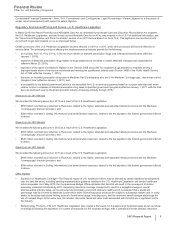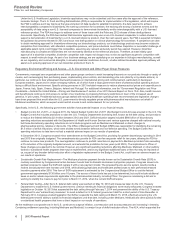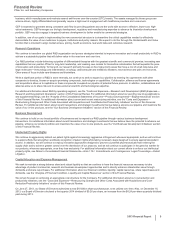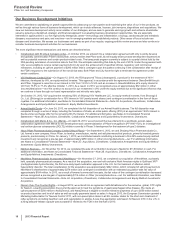Pfizer 2013 Annual Report Download - page 4
Download and view the complete annual report
Please find page 4 of the 2013 Pfizer annual report below. You can navigate through the pages in the report by either clicking on the pages listed below, or by using the keyword search tool below to find specific information within the annual report.
Financial Review
Pfizer Inc. and Subsidiary Companies
2013 Financial Report
3
• decreased government purchases of the Prevnar family of products and Enbrel in certain emerging markets (approximately $160 million);
and
• lower revenues from generic atorvastatin (approximately $145 million),
partially offset by:
• the growth of certain products, including Lyrica, Inlyta, Celebrex and Xalkori in developed markets and Xeljanz in the U.S. (approximately
$1.1 billion);
• the overall growth in the rest of the Emerging Markets business unit (approximately $751 million), excluding the aforementioned decrease
in the government purchases of the Prevnar family of products and Enbrel;
• the overall growth in the Consumer Healthcare business unit (approximately $153 million); and
• revenues from the transitional manufacturing and supply agreements with Zoetis (approximately $132 million).
In addition, Revenues were unfavorably impacted by foreign exchange of approximately $1.2 billion, or 2%, in 2013 compared to 2012.
Income from continuing operations was $11.4 billion in 2013 compared to $9.0 billion in 2012, primarily reflecting, among other items:
• patent litigation settlement income recorded in 2013 (approximately $1.3 billion, pre-tax) (see also the “Costs and Expenses––Other
(Income)/Deductions––Net” section of this Financial Review and Notes to Consolidated Financial Statements––Note 4. Other (Income)/
Deductions––Net);
• lower net charges for other legal matters (down approximately $2.2 billion, pre-tax) (see also the “Costs and Expenses––Other (Income)/
Deductions––Net” section of this Financial Review and Notes to Consolidated Financial Statements––Note 4. Other (Income)/
Deductions––Net);
• additional benefits generated from our global cost-reduction/productivity initiatives, partially offset by spending to support new product
launches;
• a gain recorded in 2013 (approximately $459 million, pre-tax) associated with the transfer of certain product rights to our equity-method
investment in China, Hisun Pfizer Pharmaceuticals Company Limited (Hisun Pfizer) (see also the “Our Business Development Initiatives”
section of this Financial Review and Notes to Consolidated Financial Statements––Note 2D. Acquisitions, Divestitures, Collaborative
Arrangements and Equity-Method Investments: Equity-Method Investments); and
• lower amortization of intangible assets (down approximately $510 million, pre-tax),
partially offset by:
• lower revenues, as discussed above;
• higher asset impairments and related charges (up approximately $211 million, pre-tax) (see also the “Costs and Expenses––Other
(Income)/Deductions––Net” section of this Financial Review and Notes to Consolidated Financial Statements––Note 4. Other (Income)/
Deductions––Net); and
• a higher effective tax rate, primarily due to a decrease in tax benefits related to certain audit settlements in multiple jurisdictions covering
various periods and a change in the jurisdictional mix of earnings (see also the “Provision for Taxes on Income” section of this Financial
Review and Notes to Consolidated Financial Statements––Note 5. Tax Matters).
Also, see the “Discontinued Operations” section of this Financial Review.
Our Operating Environment
Intellectual Property Rights and Collaboration/Licensing Rights
The loss or expiration of intellectual property rights and the expiration of co-promotion and licensing rights can have a significant adverse
effect on our revenues. Many of our products have multiple patents that expire at varying dates, thereby strengthening our overall patent
protection. However, once patent protection has expired or has been lost prior to the expiration date as a result of a legal challenge, we lose
exclusivity on these products, and generic pharmaceutical manufacturers generally produce similar products and sell them for a lower price.
This price competition can substantially decrease our revenues for the impacted products, often in a very short period of time.
Our biotechnology products, including BeneFIX, ReFacto, Xyntha, Enbrel (we market Enbrel outside of the U.S. and Canada) and the Prevnar
family, may face competition in the future from biosimilars (also referred to as follow-on biologics). If competitors are able to obtain marketing
approval for biosimilars that reference our biotechnology products, our biotechnology products may become subject to competition from these
biosimilars, with attendant competitive pressure, and price reductions could follow. Expiration or successful challenge of applicable patent
rights could trigger this competition, assuming any relevant exclusivity period has expired. However, biosimilar manufacturing is complex, and
biosimilars are not necessarily identical to the reference products. Therefore, at least initially upon approval of a biosimilar competitor,
biosimilar competition with respect to biologics may not be as significant as generic competition with respect to small molecule drugs.
We have lost exclusivity for a number of our products in certain markets and we have lost collaboration rights with respect to a number of our
alliance products in certain markets, and certain of our products and alliance products are expected to face significantly increased generic
competition over the next few years.

















